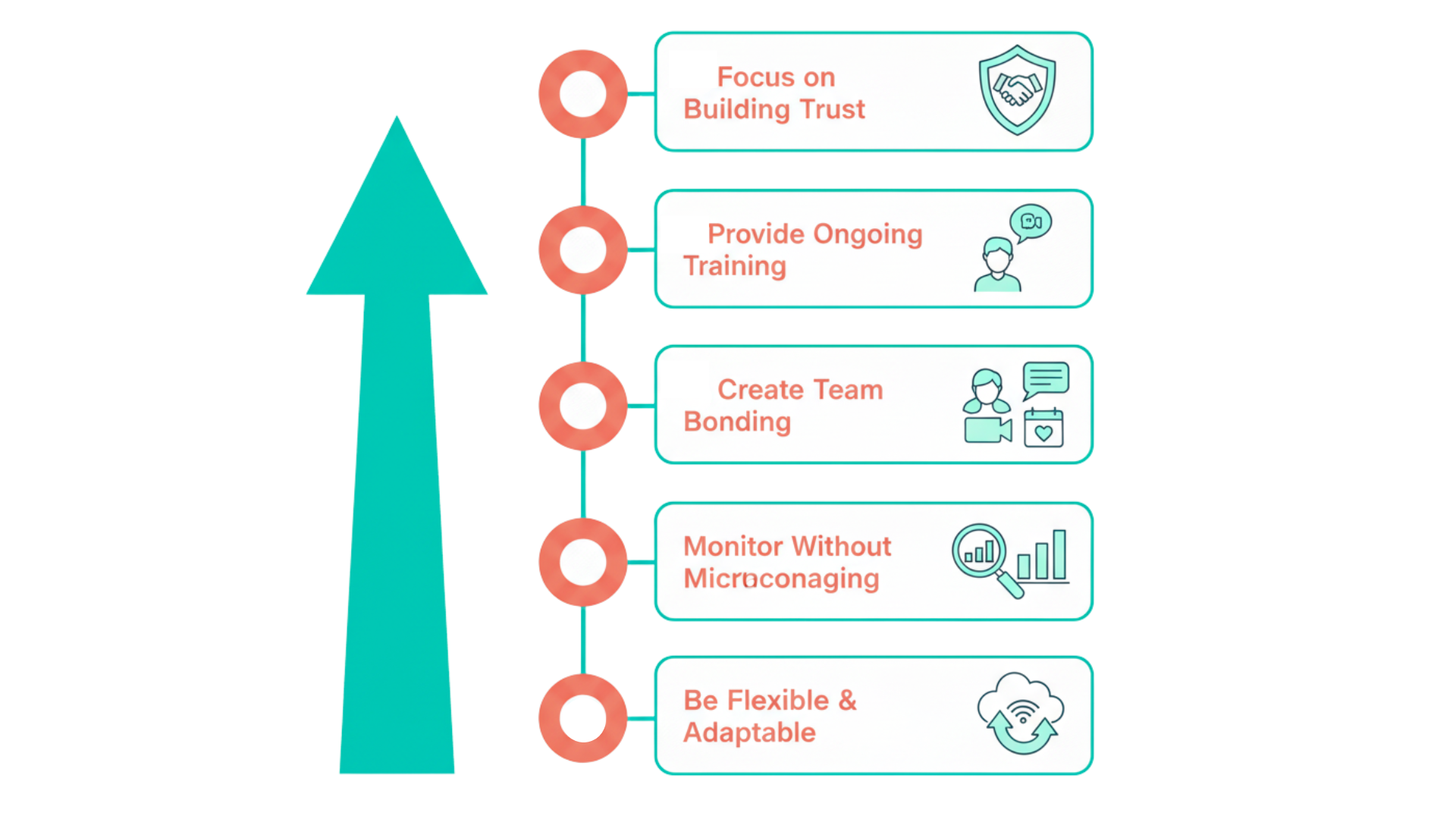10 Tips for Managing Remote Employees Effectively
Remote work has been praised as the future of business, but some leaders still hesitate to embrace it. They worry about productivity slipping, communication becoming scattered, and accountability fading away once employees are no longer in the office. Yet, many companies that have adopted remote work find the opposite to be true. With the right systems and leadership strategies in place, a remote workforce can be just as efficient, loyal, and high-performing as a traditional office team. The challenge lies in knowing how to lead them effectively.
This guide provides tips on managing remote employees that can help businesses of all sizes stay organized, productive, and confident in the success of their teams. By following these strategies, leaders can reduce stress, improve collaboration, and create an environment where employees thrive no matter where they are located.
Related Article: What Is a Remote Team? Types and Advantages
DELEGATE SMART. SCALE FAST.
The step-by-step guide to reclaim your time and grow with confidence.
1. Set Clear Expectations from the Start
One of the most common mistakes companies make when building a remote workforce is assuming employees will know what to do without structured guidelines. Clear expectations should cover work hours, communication methods, deadlines, and deliverables. When employees know exactly what is required, they can plan their workday more effectively.
Leaders should outline performance standards early. This means defining what success looks like for each role. Doing so not only creates accountability but also gives employees the confidence to prioritize their tasks. Companies that master this first step quickly discover that managing remote workers becomes less stressful and far more predictable.
2. Build Strong Communication Routines
Communication is the foundation of remote work. Without consistent communication, misunderstandings and delays can quickly pile up. Managers should establish routines for team check-ins, one-on-one conversations, and updates on ongoing projects. Regular communication gives employees the support they need and helps leaders stay in touch with progress.
For communication to work well, businesses must choose the right tools. Email, chat platforms, and video calls each serve different purposes, so a blend of them is often best. Over time, this routine ensures employees never feel isolated and managers are always in the loop. This balance is key to mastering remote team management in a way that encourages trust and collaboration.
Related Article: How To Build Your Own Remote Team Step by Step
3. Use the Right Technology Tools
Remote employees depend heavily on technology. From project management software to time-tracking apps, technology ensures everyone stays aligned. Without these tools, projects can become messy, deadlines can slip, and accountability can fade. Businesses should carefully select tools that match their goals and team size.
The right platforms create a digital workspace where employees can share documents, monitor timelines, and collaborate efficiently. Technology also helps managers measure productivity and ensure accountability without micromanaging. For leaders still asking how to manage remote teams, investing in the right technology is one of the smartest moves they can make.
4. Encourage Work-Life Balance
Remote employees often face the challenge of separating personal life from work. Since the home doubles as the office, burnout can happen faster than expected. Managers should encourage employees to log off at reasonable hours and take breaks throughout the day. Setting boundaries shows employees that leadership values their well-being, not just their output.
When employees feel supported in maintaining balance, they perform better over the long term. This also creates stronger loyalty and lower turnover rates. Companies that promote balance end up with teams that are not only more productive but also happier and healthier. These are critical benefits for anyone focused on long-term remote team management success.
5. Recognize and Reward Achievements
Recognition has always been important in the workplace, but it becomes even more valuable when employees are working remotely. Without physical proximity, it is easy for accomplishments to go unnoticed. Managers should make recognition part of their leadership style, whether it is praising an employee during a meeting or sending a personal message of appreciation.
Recognition reinforces good performance and motivates employees to continue delivering at a high level. Rewards, even small ones, further strengthen morale. Leaders who consistently recognize achievements find that managing remote workers becomes much easier because employees remain engaged and motivated.
6. Focus on Building Trust
Trust is the cornerstone of every successful remote team. Without trust, employees may feel micromanaged, while managers may constantly worry about productivity. Building trust requires consistent communication, fair treatment, and transparency in decision-making. Leaders should avoid over-monitoring, which can signal a lack of confidence in employees.
When trust is present, employees feel empowered to take ownership of their work. They are more likely to meet deadlines, stay accountable, and collaborate effectively. Companies that prioritize trust soon realize that many of the challenges in remote work are easier to overcome. For leaders searching for effective tips on managing remote employees, building trust should be at the top of their list.
7. Provide Ongoing Training and Development
Remote employees, like in-office employees, need opportunities to grow. Training not only helps them perform better but also shows that the company values their career development. Online workshops, professional development courses, and mentoring programs can all be adapted for remote teams.
When employees have access to learning resources, they remain engaged and ambitious. They also bring new skills to the table that benefit the entire organization. This is one of the most practical tips on managing remote employees because it creates a win-win scenario for both employees and employers.
8. Create Opportunities for Team Bonding
Building relationships remotely requires intentional effort. Without casual office conversations, employees may feel disconnected from each other. Managers should create opportunities for team bonding, such as virtual coffee breaks, team-building games, or online celebrations for milestones.
When employees connect on a personal level, collaboration becomes smoother and trust grows. Team bonding also reduces feelings of isolation and strengthens loyalty to the company. Leaders who invest in relationship-building will find that their team is more united, motivated, and easier to manage.
9. Monitor Performance Without Micromanaging
Managers sometimes struggle with balancing accountability and independence. Monitoring performance is necessary, but constant checking can damage trust and morale. Instead of micromanaging, leaders should set clear goals and use performance metrics to track progress.
This approach allows employees to take ownership of their tasks while still providing managers with insight into productivity. Employees appreciate the independence, and managers maintain peace of mind. Leaders exploring how to manage remote teams often find that this balance is one of the most effective solutions to long-term success.
10. Be Flexible and Adaptable
Remote work comes with unique challenges that require flexibility. Internet issues, time zone differences, and family responsibilities are realities for many employees. Leaders who remain adaptable when problems arise create a culture of understanding and resilience.
Flexibility also allows businesses to grow with changing circumstances. A rigid structure may frustrate employees and reduce productivity, but adaptability ensures the team remains efficient under different conditions. Among all the tips on managing remote employees, this one prepares companies for both present and future challenges.
Learn How We Can Help
Smart Virtual Assistant
👍🤵
Smart Virtual Assistant 👍🤵
Managing a remote team requires patience, structure, and the right strategies. Companies that invest in communication, trust, recognition, and flexibility can overcome the challenges of remote work and enjoy its many benefits. These tips on managing remote employees are a strong starting point for any leader ready to strengthen their workforce.
At Smart VAs, we specialize in supporting businesses with professional virtual assistants who bring experience and dedication to every task. Our team can help you handle scheduling, communication, project coordination, and more. By partnering with us, you can reduce stress, improve productivity, and focus on what matters most.
Reach out today to learn how our services can make managing your remote team simpler and more effective.
DELEGATE SMART. SCALE FAST.
The step-by-step guide to reclaim your time and grow with confidence.
Frequently Asked Questions
-
Managing remote employees is different because communication, accountability, and collaboration require more intentional effort. In an office, employees can quickly ask questions or receive feedback, while remote employees rely on technology to bridge the gap. Successfully managing remote workers requires clearer structures and stronger trust.
-
Performance issues should be addressed with clarity and fairness. Managers should schedule a private meeting, explain the concerns clearly, and provide specific examples. Together, both sides can agree on solutions and set measurable goals. This approach keeps communication constructive and promotes improvement without creating resentment.
-
Managers should outline work hours, deadlines, responsibilities, and communication guidelines as soon as an employee joins the team. Providing written documents or onboarding guides ensures there is no confusion. Clear expectations remove guesswork and help employees deliver consistent results.
-
Communication should be regular and structured. Team meetings, one-on-one check-ins, and updates on projects keep everyone informed. Using the right mix of tools like chat platforms, video calls, and project management systems ensures communication flows smoothly.
-
Accountability can be maintained through goal-setting, performance metrics, and regular check-ins. Managers should focus on outcomes rather than constant monitoring. When expectations are clear and trust is strong, employees are more likely to stay accountable and deliver quality work.
Ready to Work Smarter, Not Harder?
Smart VAs provides a team of highly skilled specialists from around the world, ensuring seamless support no matter the time zone. We take pride in delivering efficient, fast, and high-quality service so you can focus on growing your business. With one subscription plan, you gain access to a complete team of digital marketing experts that’s customized to your unique needs, eliminating the need to train and look for one yourself!





